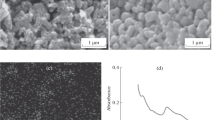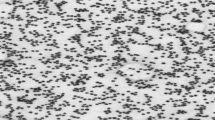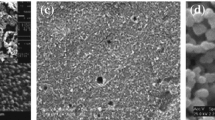Abstract
Fabrication and electrochemical characterization of adsorbed 1,2-naphthoquinone-4-sulfonic acid sodium (Nq)-modified gold electrode is described in a wide pH range (3.00–9.00) in 0.1 M phosphate buffer solution using cyclic voltammetry (CV), differential pulse voltammetry (DPV), and double-step potential chronoamperometry methods. The resulting Nq thin film-modified gold electrode (Nq/Au) was tested successfully to recognize cysteamine in an aqueous solution. It is found that cysteamine participates in Michael addition reaction with adsorbed Nq on gold electrode to form the corresponding thioquinone derivative. The reoxidation of the adduct at a potential of about 650 mV less positive than cysteamine at the surface of the bare Au electrode leads to an increase in the oxidative current, which is proportional to the concentration of cysteamine. The calibration plot for cysteamine was found to be linear in the ranges of 6.0 × 10−5–4.5 × 10−3 M and 8.0 × 10−6–5.5 × 10−4 by CV and DPV, respectively.
Similar content being viewed by others
Explore related subjects
Discover the latest articles, news and stories from top researchers in related subjects.Avoid common mistakes on your manuscript.
Introduction
Recent developments in surface chemistry can be ascribed to the progress in manipulation and modification of surface with single molecular layers [1]. Chemically modified electrodes have attracted considerable interest over the last two decades in analytical chemistry for more direct control over the chemical nature of electrodes [2, 3]. Gold substrates are now routinely used for electrochemical fabrication of thin film composites [4] and self-assembled monolayers (SAMs) [5, 6]. Gold surfaces can adsorb a wide variety of ions, atoms, and molecular functional groups, which is often accompanied by oxidation–reduction or dissociation of them [7–12]. The results indicate that the formation and orientation of the ordered adlayers of organic molecules on a solid–electrolyte interface play important roles in the electron transfer [13]. The surface properties of an adsorbed species are affected by factors such as its pH-value, its concentration [14], temperature [15], the electrode potential [9], and the surface atom orientation [16]. In particular, these factors may influence the adsorbate composition, orientation, molecular symmetry, conformation, electrochemical reactivity, and chemical reaction pathways [17]. Further research in this aspect can contribute to the development of industrial application of this technology, such as applications in batteries, fuel cells, electrocatalysis, and electroplating processes. Especially, a few modifiers containing hydroquinone groups have been introduced for chemically modified electrodes in literatures [18–20]. Thus, the studies on the relationship between electron transfer and adsorbate orientation will be quite useful to elucidate such interfacial processes.
2-Mercaptoethylamine (cysteamine) is an aminothiol compound used as a drug for the treatment of cystinosis [21]. Cysteamine crosses the plasma and lysosomes, and it reacts with crystallized cystine within the lysosomes to form cysteine and cysteine–cysteamine mixed disulfides, which leave through the lysine porter [22]. The cysteamine and its disulfide, cystamine, have been shown to be neuroprotective in a number of cell culture and animal models [23]. The thiol functional group in cysteamine acts as a potential antioxidant in oxidative stress conditions such as after radiotherapy. Due to the important role of cysteamine in clinical settings and its potential future applications as an antioxidant, it is necessary to develop an analytical method for detecting cysteamine in biological samples [24]. Various analytical methods have been cited for the determination of cysteamine in biological fluids, such as high-performance liquid chromatography [22], ion exchange column chromatography [25], high-voltage electrophoresis [26], electrochemical detection [27, 28], and gas chromatography with flame photometric detection [29]. These procedures, however, are either complex or time consuming and involve pre-treatment of the biological samples.
In this work, Nq was used to modify the gold electrode surface, where it exhibits reversible electron transfer behavior. Here, we report detailed electrochemical investigations of Nq at gold electrodes, which exhibit strong electrochemical response toward cysteamine oxidation using Michael addition reactions. The effect of adsorption time, pH-value, and Nq concentration was investigated. The selectivity of the reaction has been assessed with amino acids. We have, thus, developed a method that is simple, sensitive, and rapid for analyzing cysteamine.
Experimental
Instrumentation
Voltammetric experiments were performed with an Autolab Potentiostat/Galvanostat (Netherlands) coupled with a Pentium IV personal computer. The three-electrode (Metrohm) system consists of a bare or chemically modified Au electrode (with diameter 1.8 mm) as a working electrode, Ag|AgCl|KCl3M as the reference electrode, and a platinum wire as an auxiliary electrode.
Reagents and solutions
All chemicals were of analytical reagent grade and were used without further purification. Doubly distilled water was used to prepare buffer and reagent solutions. Buffer solutions were prepared from orthophosphoric acid and its salts in the pH ranges from 3.00 to 10.00. Potassium chloride (Fluka) was used as the supporting electrolyte. 1,2-Naphthoquinone-4-sulfonic acid sodium salt and cysteamine were obtained from Fluka.
Fabrication of the Nq/Au electrode
For electrochemical experiments, the Au surface was freshly polished prior to each experiment with 0.05 μm α-alumina paste, rinsed with doubly distilled water, and finally cleaned ultrasonically in water and 96% ethanol, respectively, for 5 min. The Nq/Au electrode was obtained by immersing in 0.1 mM Nq solution for 30 min at room temperature, followed by washing the electrode with doubly distilled water to remove the residual Nq.
Results and discussion
Electrochemical behavior of the Nq film
The electrochemical properties of Nq/Au electrode were studied in 0.1 M phosphate buffer solution (pH 6.00) with 0.1 M KCl as the supporting electrolyte. The cyclic voltammogram (Fig. 1A, curve a) exhibits an anodic peak (Epa = 270 mV), corresponding cathodic peak (Epc = 164 mV), half wave potential (E1/2 = 217 mV) vs Ag|AgCl|KCl3M, and peak separation potential (ΔEp = 106 mV). The results show that well-defined and reproducible anodic and cathodic peaks related to Nq redox system with quasi-reversible behavior. Thus, Nq can be used as an indicator agent for the electrochemistry of some important biological compounds with slow electron transfer. The peak current was found to increase linearly with scan rates from 20 to 500 mV s−1 (not shown), showing that the electrode reaction is the surface process. The cyclic voltammogram of bare Au in pure supporting electrolyte shows no anodic or cathodic peaks (Fig. 1A, curve b).
A Cyclic voltammograms of (a) Nq/Au electrode in the absence, (b) bare Au electrode in the absence, and (c) Nq/Au electrode in the presence of 1.0 mM cysteamine in 0.1 M phosphate buffer solution (pH 6.00) containing 0.1 M KCl as the supporting electrolyte at a scan rate of 50 mV s−1. B Cyclic voltammetry response of 1.0 mM cysteamine at a surface Au
The surface coverage concentration (Γ) of Nq was evaluated from the following equation [30]:
where Q is the charge obtained by integrating the anodic peak at a low-voltage scan rate (50 mV s−1) and the other symbols have their usual meaning. In this case, the calculated value of Γ is 8.64 × 10−10 mol cm−2.
Electro-oxidation of cysteamine at Nq-modified electrode
The electro-oxidation of cysteamine at Nq/Au electrode was investigated in a 0.1 M phosphate buffer solution containing 0.1 M KCl at pH 6.00. The direct electrochemical oxidation of cysteamine at the surface of a bare electrode is irreversible with a peak potential of nearly 800 mV versus Ag|AgCl|KCl3M (Fig. 1B). As shown in the cyclic voltammogram (Fig. 1c), the oxidation peak potential of cysteamine at Nq/Au electrode shifted almost 650 mV to the less positive than that at bare Au electrode. Since some reactive sites in the Nq film are exposed to the solution phase, the electro-oxidation product of adsorbed Nq units on the surface of Au electrode undergoes a chemical reaction (Michael addition) with cysteamine as a nucleophilic agent to produce the reduced adduct compound. The presence of the thiol moiety in the structure of the product, due to its electron donating property, facile the electro-oxidation of the additional product and decrease its anodic potential toward less positive potential. Therefore, the re-oxidation of the adduct leads to an increase in the anodic current, the magnitude of which is proportional to the concentration of cysteamine in the solution.
Optimization of parameters influencing the voltammetry determination of cysteamine
Effect of Nq immobilization methods
The immobilization of Nq on Au electrode was carried out using two different methods: by cyclic voltammetric scanning for 30 cycles at the potential between 0.10 and 0.45 V at 50 mV s−1 and by immersing adsorption. The results showed that the amount of Nq immobilized by the cyclic voltammetric method was smaller. The immersing adsorption method could immobilize a much larger amount of Nq and obtain a well-defined CV peak. This approach was used in the following experiments. Figure 2 shows the cyclic voltammograms of the 1.0 mM cysteamine at the surface of Nq/Au electrode prepared using two different methods.
Effect of adsorption time
The immersing adsorption time of the Nq active layer determines the magnitude of the current response. Nq was deposited on Au electrode by immersing in 0.1 M Nq solution for different times. Then, the electrochemical properties of the immobilized Nq were followed by recording the CV in the 1.0 mM cysteamine solution containing 0.1 M KCl. The cyclic voltammograms show that the anodic peak current increased with increasing of the deposition time and reached a maximum value at a deposition time of 30 min (Fig. 3). Therefore, 30 min was selected as the optimum deposition time for the deposition of Nq on the Au electrode.
Effect of pH-value
The pH-value of the buffer solution had a certain influence on the electrochemical reaction of Nq with cysteamine. We performed a series of experiments using 0.1 M phosphate buffer solutions with different pH values (3.00–9.00). According to I-pH curve (Fig. 4), pH = 6.00 was chosen as the optimum pH-value for the voltammetric determination of cysteamine at the Nq/Au electrode.
Effect of Nq concentration
The effect of Nq concentration in the immersing solution on the electrochemical behavior of cysteamine at the prepared Nq/Au electrode was studied by CV method. The result shows that the best electrochemical properties of cysteamine were obtained at the prepared Nq/Au electrode from 0.1 mM Nq solution as immersing solution (Fig. 5).
Chronoamperometry studies
Double-step potential chronoamperometry was employed to investigate the electrochemical processes at the Nq/Au electrode. Figure 7a shows the current–time curve of the Nq/Au electrode in 0.1 M phosphate-buffered solution by setting the working electrode potential at the 0.4 V (first potential step) and −0.2 V (second potential step) vs Ag|AgCl|KCl3M. The results show very symmetrical chronoamperograms with an equal charge consumed for the oxidation and reduction of the Nq redox couple on the Au electrode surface. Also, we studied the electrochemical behavior of the Nq/Au electrode in an aqueous-buffered solution (pH 6.00) in the presence of various concentrations of cysteamine (Fig. 6b–e). The oxidation current value increases with increasing of the cysteamine concentration at the first potential. The results show that cysteamine participates in the reaction with adsorbed Nq on the gold electrode, which increases the oxidation current. However, in the presence of cysteamine, the charge value associated with forward chronoamperometry is greater than that observed for backward chronoamperometry (Fig. 6B, curves a′ and b′). Therefore, the film-forming property of Nq on the Au substrate surface was confirmed by chronoamperometry.
A Double-step potential chronoamperograms of the Nq/Au electrode in the (a) absence and presence of (b) 0.5, (c) 1.0, (d) 1.5 and (e) 2.0 mM of cysteamine in 0.1 M phosphate buffer solution (pH 6.00). First and second potential steps were 0.40 and −0.20 V vs Ag|AgCl|KCl3M. B The charge–time curves: (a′) for curve (a) and (b′) for curve (b)
Interference study
Possible interference for the detection of cysteamine at the Nq/Au electrode was investigated by the addition of various amino acids to 0.1 M phosphate buffer solution in the presence of 1.0 mM cysteamine. Amino acids such as tyrosine, lysine, methionine, tryptophan, and alanine in fivefold concentration did not show interference to cysteamine determination, while other compounds possessing sulphydryl thiol functionalities (d-penicillamine and l-cysteine) showed interference, which found to react through a similar route to that observed with cysteamine (Fig. 7).
Cyclic voltammograms of the Nq/Au electrode in the presence of (a) 0.3 mM L-cysteine, (b) 0.3 mM D-penicillamine, (c) 0.3 mM cysteamine, and (d) 0.3 mM D-penicillamine +0.3 mM cysteamine in 0.1 M phosphate buffer solution (pH 6.00) containing 0.1 M KCl as supporting electrolyte at a scan rate 50 mV s−1
Stability of the Nq film-modified electrode
Stability of the Nq film-modified electrode stored in 0.1 M phosphate buffer solution was investigated by measuring the current response of 1.0 mM cysteamine every few days. After being stored for 10 days in 0.1 M phosphate buffer solution, the response current of the Nq film-modified electrodes decreases gradually to 80% of the initial value. The good stability of the Nq-film modified electrode offers interesting opportunity for practical applications in biosensing and bioengineering.
Voltammetric determination of cysteamine
The feasibility of using the Nq/Au electrode for the voltammetry of cysteamine in an aqueous-buffered solution was tested. Cyclic voltammetry and differential pulse voltammetry techniques were used in the experiments. The anodic peak current (Fig. 8) increased with the cysteamine concentration in the solutions on the Nq/Au electrode surface. Under the optimum conditions, the CV and DPV peak currents were linearly related to cysteamine concentrations over the range from 6.0 × 10−5 M to 4.5 × 10−3 M and 8.0 × 10−6 M to 5.5 × 10−4 M, respectively. The detection limits (2σ) were determined as 36 μM and 5.2 μM by CV and DPV. Acceptable recovery and reproducible data were obtained as shown in Table 1.
A Cyclic voltammograms of the Nq/Au electrode in the presence of (a) 0.07, (b) 0.20, (c) 0.50, (d) 0.90, (e) 1.40, (f) 2.00 and (g) 2.50 mM of cysteamine in 0.1 M phosphate buffer solution (pH 6.00) at a scan rate of 50 mV s−1 on Nq/Au electrode surface. B and C plot of peak current versus cysteamine concentrations by CV and DPV, respectively
Conclusion
It has been shown that it is possible to construct an Nq/Au electrode by electrodeposition or immersing adsorption methods of 1,2-naphthoquinone-4-sulfonic acid sodium. The characterization of Nq film has been studied by the electrochemical methods. An Nq film-coated electrode showed efficient electrochemical functions toward cysteamine oxidation in the presence of interferences such as tyrosine, lysine, alanine, and tryptophan. The chemical addition–reduction process (Michael addition) of an Nq/Au electrode toward the oxidation of cysteamine as a nucleophilic agent was characterized by electrochemical measurements. The Nq/Au electrode is found to be effective for the construction of selective, sensitive, and stable biosensors.
References
Mirsky VM (2002) Trends Anal Chem 21:439
Ojani R, Pournaghi-Azar MH (1999) J Solid State Electrochem 3:392
Ojani R, Pournaghi-Azar MH (2000) J Solid State Electrochem 4:75
Walters MJ, Garland JE, Pettit CM, Zimmerman DS, Marr DR, Roy D (2001) J Electroanal Chem 499:48
Clark BK, Standard JM, Gregory BW, Hall AD (2002) Surf Sci 488:285
Patangwasa W, Hodak JH (2008) Mater Chem Phys 108:45
Hubbard AT, Gui JY (1991) J Chem Phys 88:1547
Song D, Soriaga MP, Hubbard AT (1985) J Electroanal Chem 193:255
Chia VKF, Soriaga MP, Hubbard AT (1984) J Electroanal Chem 167:97
Lu F, Salaita GN, Laguren-Davidson L (1988) Langmuir 4:637
Stern DA, Wellner E, Salaita GN (1988) J Am Chem Soc 110:4885
Stern DA, Salaita GN, Lu F (1988) Langmuir 4:711
Peng H, Dong-xue H, Li N, Hai-bo L (2006) Chem Res Chinese U 22:493
Soriaga MP, White JH, Hubbard AT (1983) J Phys Chem 87:3048
Soriaga MP, Hubbard AT (1984) J Phys Chem 88:1758
Soriaga MP, Hubbard AT (1982) J Am Chem Soc 104:2735
Salaita GN, Hubbard AT, Murray RW (eds) (1992) Techniques of Chemistry, vol XXII, Molecular Design of Electrode Surfaces
Moore ANJ, Katz E, Willner I (1996) Electroanalysis 8:1092
Pamidi PVA, Wang J (1996) Electroanalysis 8:244
Mukae F, Takemura H, Takehara K (1996) Bull Chem Soc Jpn 69:2461
Gahl WA (2003) Eur J Pediatr 162:38
Ogony J, Mare S, Wu W, Ercal N (2006) J Chromatogr B 843:57
Wood L, Amin Khan M, Moskal R (2007) Brain Research 158:158
Lochman P, Adam T, Fredecky D, Hlidkova E, Stopover Z (2003) Electrophoresis 24:1200
Hsiung M, Yeo YY, Itiaba K, Crawhall JC (1978) Biochem Med 19:305
Jonas AJ, Schneider JA (1981) Anal Biochem 114:429
Smolin LA, Schneider JA (1988) Anal Biochem 168:374
Garcia RA, Hirschberger LL, Stipanuk MH (1988) Anal Biochem 170:432
Kataoka H, Tanaka H, Makita M (1994) J Chromatogr B 657:9
Salimi A, Hallaj R, Amini MK (2005) Anal Chim Acta 534:335
Author information
Authors and Affiliations
Corresponding author
Rights and permissions
About this article
Cite this article
Raoof, JB., Ojani, R. & Chekin, F. Immobilization of 1,2-naphthoquinone-4-sulfonic acid on gold electrode: application for cysteamine detection using Michael addition. J Mater Sci 44, 2688–2693 (2009). https://doi.org/10.1007/s10853-009-3352-8
Received:
Accepted:
Published:
Issue Date:
DOI: https://doi.org/10.1007/s10853-009-3352-8












